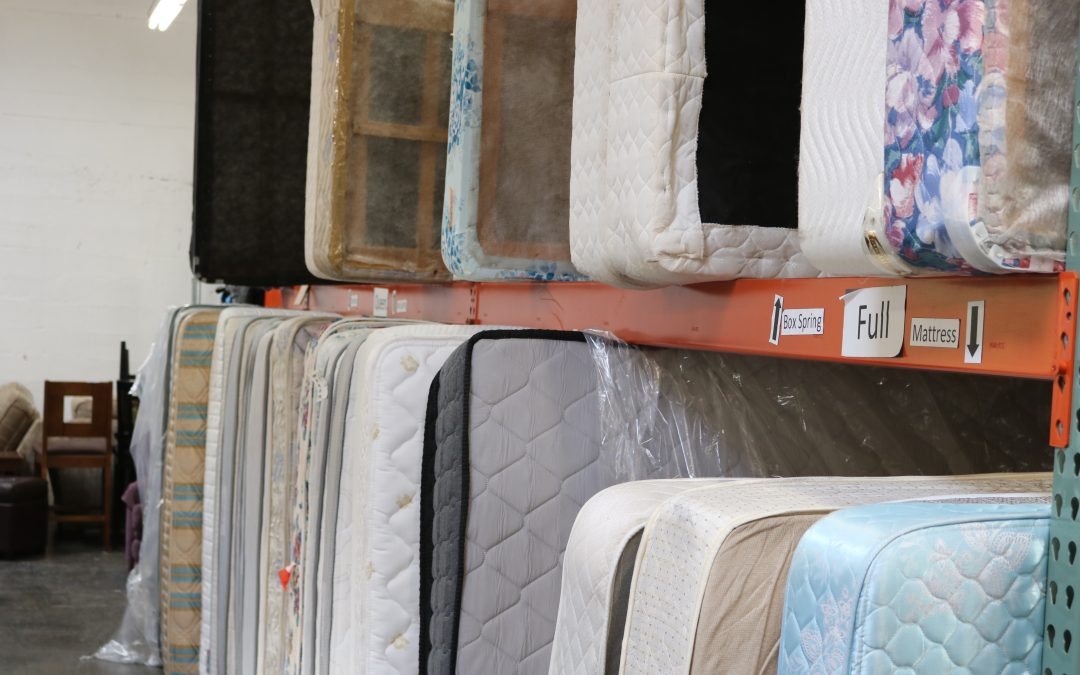By Cara Griffin
Cara is a writer and editor whose work supports organizations and individuals creating a more humane and sustainable built environment. Learn more about her at www.caragriffin.me.
From straw-filled sacks to memory foam marvels, mattresses have come a long way. But no matter the type, one thing remains true: everyone deserves a comfortable place to rest. Unfortunately, many in the Portland region go without this basic comfort, making mattresses a critical need at Community Warehouse.
A Brief History of Mattresses
The concept of dedicated sleeping surfaces has ancient roots. Archaeologists have discovered evidence of plant-based bedding at Border Cave in South Africa, dating back to around 200,000 years ago. These early beds consisted of layers of grass and other plants, providing comfort and repelling insects.

Over time, sleeping arrangements evolved significantly across different cultures. In ancient Egypt, the elite slept on raised beds with wooden frames. These beds used woven leather or reed matting as the sleeping surface, sometimes covered with linen sheets and cushions stuffed with natural materials.

Credit: ddenisen, via Wikimedia Commons
In medieval Europe, people typically slept on mattresses called “ticks,” which were large sacks filled with straw or hay; the wealthy might use wool or feathers for added comfort. Commonly, ropes strung across bedframes supported the mattress; the need to keep those ropes tight to avoid sagging may be the origin of the phrase “sleep tight.”

A major revolution in mattress technology came in the mid 19th century when steel spring coils–already used in furniture and buggy cushions–began to be incorporated into mattresses. In By the end of the century, James Marshall of invented individually wrapped coil springs, laying the foundation for modern innerspring mattresses, though they didn’t become widely popular until after World War 1.
Various alternatives to innerspring mattresses became common in the 20th century. Memory foam, originally developed by NASA in the 1960s, found its way into mattresses in the 1980s and grew popular. inthe 1990s. The 1970s and 1980s saw a surge in waterbed popularity. Latex mattresses, first introduced in the 1930s, gained traction in the late 20th century as alternatives to traditional.
Towards the century’s end, hybrid mattresses emerged, combining technologies like innersprings with memory foam. Despite these advancements, the fundamental importance of a comfortable sleeping surface remains unchanged—it’s crucial for restful sleep and overall well-being.
As one of our clients shared,
“This is the first time I’ve had a bed in three years. I’ve been sleeping on a recliner. I’m so appreciative of what you do! This is the hand-up we’ve been looking for.”
The Mattress Challenge: Disposal and Reuse
While modern mattresses offer unmatched comfort, they present a significant environmental challenge. Mattresses are bulky, hard to recycle, and often end up in landfills. Instead of contributing to waste, your gently used mattress can provide comfort to someone who needs it.
Community Warehouse is one of the few places in the Portland region that accepts donated mattresses, ensuring they go to families in need rather than landfills.

The Impact of a Mattress Donation
The impact of a single mattress donation can be profound. In 2023 alone, Community Warehouse gave away 3,120 mattresses, helping 3,302 people from 1,517 households.
The real impact is in the stories of the individuals who benefit. “I love my mattress. I haven’t slept this good in over 500 days (no joke). My boys are getting better sleep now too!” shared one client.
“I love my mattress. I haven’t slept this good in over 500 days (no joke).”
Donation Guidelines and Process
Community Warehouse is always in need of gently used mattresses in sizes from twin to queen. To uphold the dignity of the clients who visit the furniture bank, please ensure that your donation is clean and free of stains, tears, or other damage.
Donating is easy! You can drop off your mattress, or take advantage of our pickup service. Your donation doesn’t just provide a mattress—it provides comfort, stability, and the chance for restful sleep.


